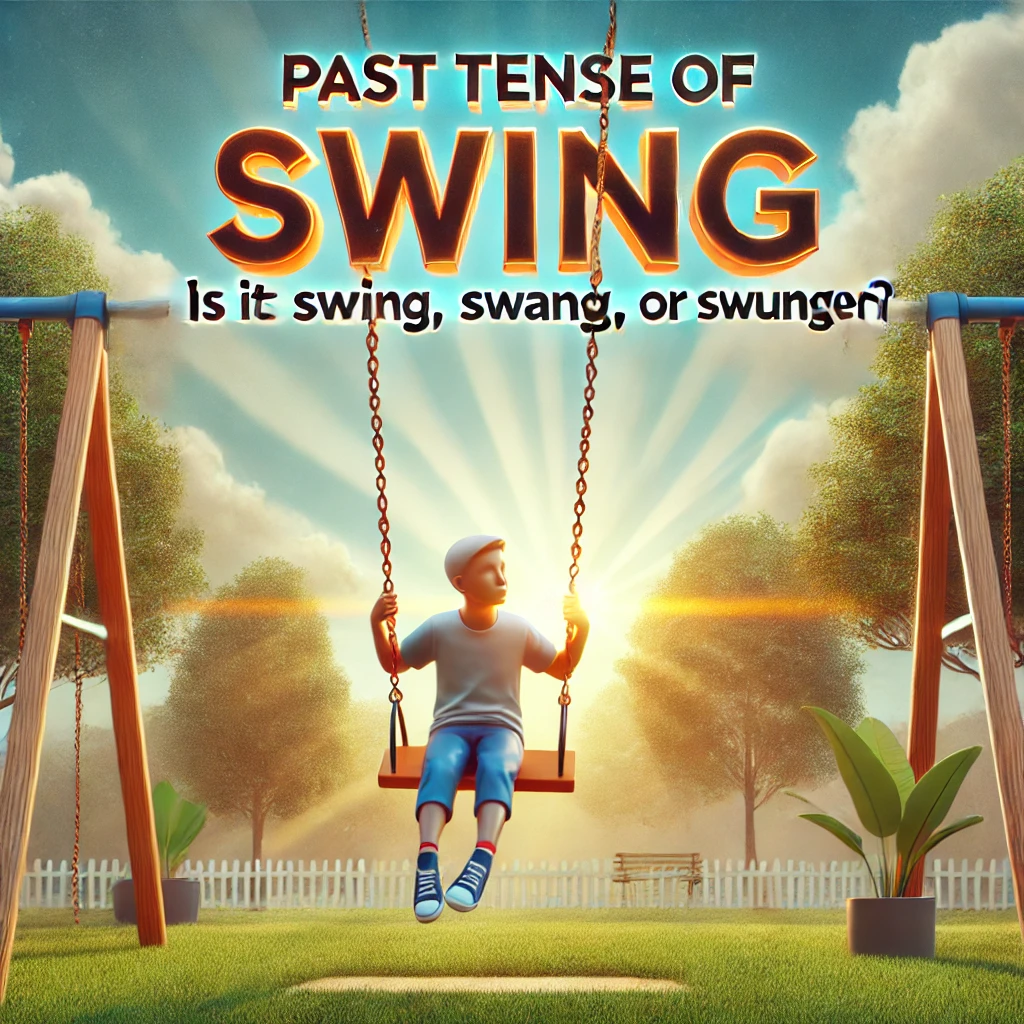Introduction
English is full of surprises, especially when it comes to verb conjugation. Some verbs follow clear, predictable patterns, while others throw us curveballs. The word “swing” belongs to the latter category, often leaving people wondering: Is the past tense of swing “swang” or “swung”?
If you’ve ever hesitated before writing or saying the past tense of swing, you’re not alone. This article will explore the correct past tense form, the historical evolution of “swing,” and the difference between swing, swang, and swung.
Past Tense of Swing: What’s the Correct Form?
The correct past tense of swing is “swung.” The verb “swing” is an irregular verb, meaning it doesn’t follow the usual -ed rule. Instead, it changes form in a less predictable way.
Here’s how “swing” conjugates across different tenses:
| Verb Form | Example Sentence |
|---|---|
| Present | I swing on the rope every afternoon. |
| Past | Yesterday, I swung across the river. |
| Past Participle | I have swung on this swing many times. |
So, where does “swang” fit in? While some people use “swang” as the past tense, it’s not standard English. “Swang” was once acceptable in older dialects but is now considered incorrect.
Read More About This Article: Afterward vs Afterwards: Understanding the Difference and Proper Usage
Understanding Irregular Verbs and How They Work
Unlike regular verbs that simply add -ed for past tense (e.g., walk → walked), irregular verbs change in different ways. “Swing” follows a pattern similar to other irregular verbs like:
- Sing → Sang → Sung
- Ring → Rang → Rung
However, despite this pattern, English speakers don’t say “swang” in modern usage. Instead, the standard past tense remains “swung.”
Swing and Swung: Historical Evolution of the Verb
Etymology of “Swing”
The word “swing” originates from the Old English “swingan,” meaning “to strike, to beat, or to rush.” Over time, it adopted meanings related to motion, including:
- Moving back and forth (The door swung open.)
- Controlling momentum (He swung the bat and hit a home run.)
- Shifting opinions or emotions (The election swung in her favor.)
How Verb Conjugation Evolved
In older English dialects, people sometimes used “swang” as a past tense form. You might still find it in literature from the 19th or early 20th centuries. However, “swung” became the dominant past tense form over time, and today, grammar guides and dictionaries recognize only “swung” as correct.
Common Misconceptions About the Past Tense of Swing
Is “Swang” Ever Correct?
Although “swang” might sound right to some, it’s not grammatically accepted in modern English. However, some regional dialects or older texts may still use it informally.
Does “Swinged” Exist?
No. “Swinged” is never correct as the past tense of “swing.” The only correct past tense is “swung.”
Physical vs. Metaphorical Use of Swing and Swung
The word “swing” appears in both literal (physical) and figurative (metaphorical) contexts.
Physical Sense
- Definition: Describes an actual back-and-forth motion.
- Examples:
- The child swung on the playground swing.
- She swung the door open forcefully.
Metaphorical Sense
- Definition: Implies a change in state, opinion, or emotion.
- Examples:
- The market swung in favor of investors.
- His mood swung from joy to frustration.
Understanding these differences helps in choosing the right verb tense in different contexts.
Case Study: Grandfather Clocks and the Rhythmic Swing
One of the most well-known examples of a swinging motion is the pendulum of a grandfather clock.
How It Works
A pendulum swings back and forth, regulating time by controlling the movement of gears. This rhythmic motion has influenced common phrases like:
- “The pendulum has swung” (meaning situations have changed drastically)
- “Swung into action” (meaning someone responded quickly)
Usage Examples in Sentences
- The grand clock pendulum swung steadily, marking the passage of time.
- His opinion swung dramatically after hearing the new evidence.
This example shows how “swing” is deeply embedded in both everyday language and historical references.
Practical Tips for Using Swing and Swung Correctly
Quick Rules to Remember
- If referring to the past, always use “swung.”
- Never use “swang” in formal writing.
- If unsure, check a dictionary or grammar guide for confirmation.
Common Phrases with “Swung”
Here are some phrases using “swung” correctly:
- She swung the hammer with full force.
- The door swung open in the wind.
- He swung his backpack over his shoulder.
By remembering these examples, you’ll never second-guess your verb choice again.
Conclusion
To summarize:
✅ The correct past tense of swing is “swung.”
❌ “Swang” was historically used but is no longer correct.
❌ “Swinged” is never a correct form.
Grammar rules may evolve, but in modern English, “swung” is the only acceptable past tense. Whether you’re writing, speaking, or editing, stick with “swung” to ensure clarity and correctness.
Next time you hear someone say “swang,” you can confidently correct them—because now, you know the facts!
